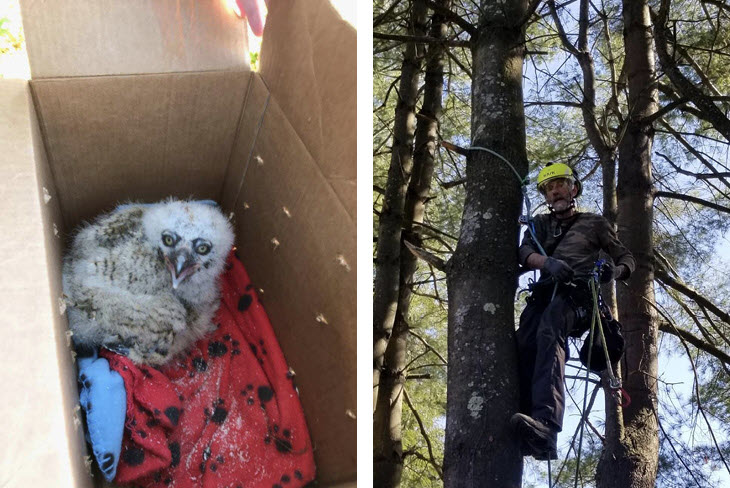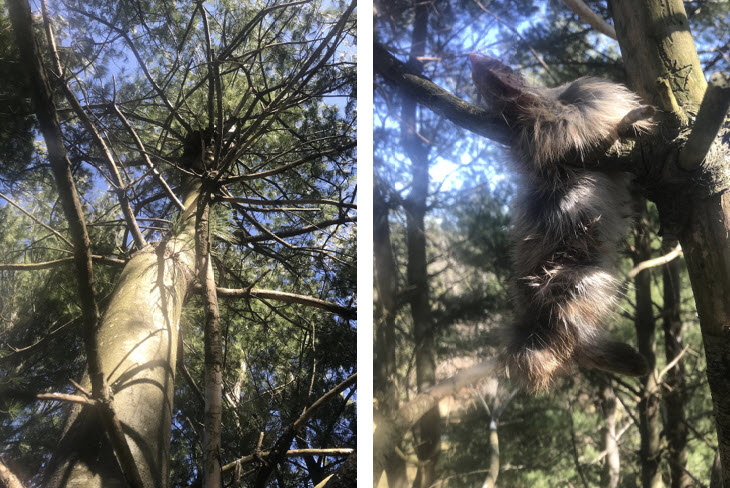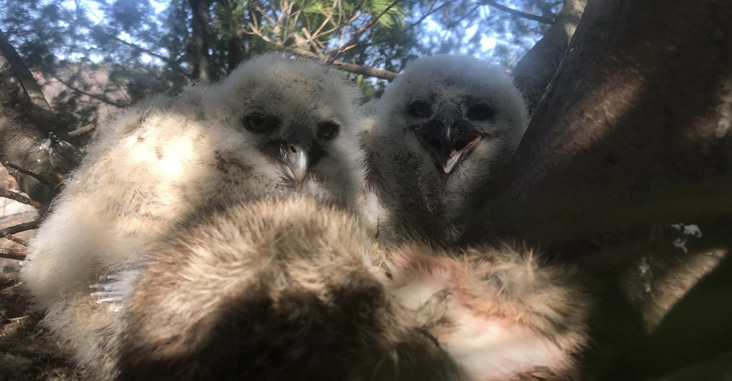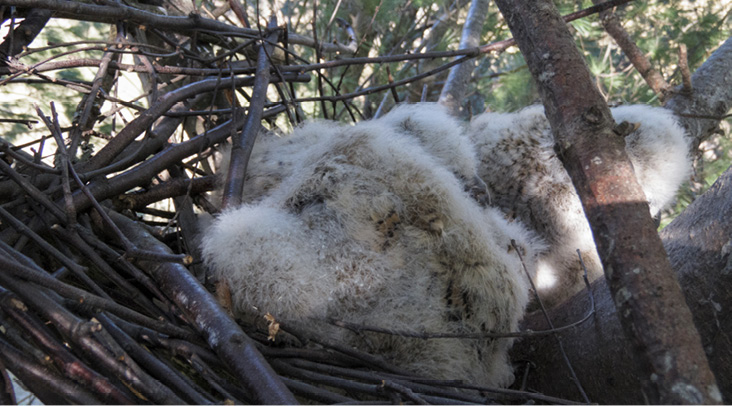Andrew Joslin

Left: Great Horned Owl waiting to be put back in its nest. Right: Climbing the hard way, no substantial limbs to set a rope on. Photographs by Kirsten Hirschler.
On the afternoon of Friday, March 27, 2020, I found myself standing in a grove of young white pines looking up through my binoculars at a pair of Great Horned Owls (Bubo virginianus). One of the adult owls was on its nest, and the other was on a small pine branch just above and to the left. I was there because I am an arborist and recreational tree climber who has rescued many animals from trees. On this day, my task was to return a fallen owlet to its nest.
I have had a strong interest in New England natural history since my youth, and I started birding seriously in my early thirties. Now as a 64-year-old rope and harness tree climber, I am often called upon to rescue pet cats stuck in trees. As my reputation among eastern Massachusetts animal control officers and wildlife rehabilitators has grown, I've become a regular resource for this task. Most fire and police departments no longer assist with animal in a tree rescues, so it is now up to an informal network of willing climbers to help out. Along the way I have climbed trees to capture many cats as well as a growing list of other species in trouble: an injured adult Great Horned Owl, an escaped pet parrot, and a sick raccoon captured at the request of a wildlife rehabilitator. My most ironic rescue was an escaped pet squirrel. The young owner had raised the found squirrel from a "pinky" and was very worried. The squirrel looked quite at ease in the very top of a Norway maple.

Left: Halfway there. Right: Parts of a cottontail rabbit dropped from the nest. Photographs by the author.
Earlier the same day, I was contacted by Westford, Massachusetts, Animal Control Officer and wildlife rehabilitator Kirsten Hirschler. She was checking on my availability to help put a fallen Great Horned Owl back in its nest. Kirsten, who is active in the Massachusetts wildlife rescue and rehabilitation community, put me in touch with Joanne Adey of Adey Wildlife Rehabilitation in Ashburnham, Massachusetts. Joanne had responded to a "baby owl on the ground" call from a homeowner in Lexington, Massachusetts, the day before. Joanne is federally licensed to handle raptors for rescue and rehabilitation purposes. She arrived at the scene and determined that the young owlet needed assistance.
Great Horned Owl young are capable climbers and will climb a tree to get back to their nest after a fall. Even if an owlet cannot climb up, the parents will continue feeding the young wherever they are. In the niche white pine habitat between two well landscaped suburban yards there was very little cover on the ground. The needle duff layer provided a soft landing, but there was a chance that a domestic cat, dog, or a wild predator would end the owlet's youthful adventure. Joanne captured the owlet and took it to her facility. Overnight she provided it with subcutaneous hydration and fed it thawed lab mice. The "patient" responded well and ate with gusto. In the morning Joanne reached out to the wildlife rescue and rehabilitation community to locate a climber to put the owl back in its nest.
When I arrive at an arboreal rescue scene I never know what I'm going to find. Cats don't care about the condition or the species of tree they've chosen to climb, and they vary greatly on where they decide to perch in a tree. Some will go to the very uppermost twigs on a tall white pine, and others will settle in on a stout oak limb just out of ladder reach from the ground. As I studied the owl nest, I also assessed the tree. It was a skinny white pine with a sound trunk that was about 70 feet tall. The nest was on a natural shelf at about 55 feet from the ground. The pine's original top had broken in a storm and the new top which regrew from a side branch curved out slightly from the upper trunk.

Two siblings and rabbit remains in the nest. Photograph by the author.
Something had built a small nest on this narrow shelf, possibly a crow or even a Mourning Dove. Or it could have been the remains of a squirrel's nursery drey. It was now a very minimal Great Horned Owl nest. It is likely that the owlet fell because of the small size and no sides to the nest. Owl young grow fast and space was becoming limited up there. The fallen owlet could have been jostled out by a sibling competing for rabbit parts or by a gust of wind. It was clear to me that I would need to increase the size of the nest and to reinforce it to make it safer for the young. While I prepared to climb, Kirsten and Joanne gathered sticks and twigs for the rebuild.
There are many ways to climb a tree with rope and harness. The classic way to ascend a conifer to a raptor nest is to use lineman's spikes, or spurs as tree climbers call them, attached to the climber's boots. This technique is fast and effective but is not good for the tree. Punching holes up the trunk of a tree with sharp spikes can make a tree more vulnerable to bark beetles and fungal intrusion. The current rule in modern tree care is to use spurs only for removals.
An alternative method is to set a rope for climbing. For this method, I throw a 10-ounce weighted bag trailing a high-strength braided cord up over a strong anchor limb. Then I attach my climbing line to the throw line and pull it up over the anchor limb. This tree, however, had no substantial live side branches below the nest, and there was nothing to anchor a rope to above the nest.
Without a safe option for a canopy anchor, I elected to climb the hard way; I alternately choked a short rope called a lanyard and my long rope on the trunk and gradually worked my way up.

The third sibling returned, the lump of down in the foreground. Photograph by the author.
As I started climbing, the adult owl on the small branch left the tree. It flew to a large Norway spruce, though, within a minute or two, a red-tailed hawk came in and chased the owl out of the spruce. Working my way up through the dead branch zone I came across the remains of a cottontail rabbit draped over a branch, and a few feet above that the hollowed-out rear third of a rat, tail still attached. No doubt the parents were excellent hunters and providers. The owl on the nest remained and watched me intently as I climbed—I'm guessing this bird was the female. She stayed put as I worked my way through 30 or so feet of the typical dead branch zone on a white pine. When I was about 20 feet below the nest she flew. As I reached the nest, she flew under me twice but never came close to me.
Looking into the nest I found two young owls hunkered down. They looked a bit alarmed and alternately hissed and clicked their mandibles—typical owl defense behaviors. I waited for them to calm down a little and called for Joanne and Kirsten to attach the bundle of sticks to the end of my climbing line. I pulled the bundle up and began weaving the sticks in to give them more room and to provide a "guardrail" against falling. The nestlings remained calm as I worked, and I was careful not to poke or jostle them. There were some strong gusts as I was working. When wind blows hard, white pine tops move a lot as the tree's crown absorbs the wind energy and dissipates it by moving freely. I had to stop working a couple of times to wait until a gust was over. During the harder gusts the owlets put their heads down. They instinctively knew that standing up straight was not a good strategy in that wind.
With the nest structure improved, I called to the ground for the owlet to be placed in a secure bag and attached to the end of my rope. The owl weighed about 580 grams and felt like nothing as I pulled it up. I carefully removed it from the bag and placed it in the nest. The returning owlet immediately huddled with its siblings, creating what looked like a unified lump of owl down. I called to the ground that the mission was accomplished, and a small cheer rose up into the upper pine branches.
I descended from the tree and derigged my climbing rope. After packing up my gear I took a look around to see if I could spot the parents anywhere. No luck. As large as they are, an adult Great Horned Owl can easily disappear into the thickly-needled upper branches of a white pine or Norway spruce. After returning home I heard from Joanne that the property owner had seen both adult owls come back to the nest. As of April 1, 2020, the parents were actively attending to the nestlings, and the young were observed looking out over the nest edge.
On Saturday morning April 4, however, I received a text message that an owlet was again on the ground at the Lexington nest site. The previous two days had been extremely windy with driving rain from a coastal storm. When I arrived, I inspected the nest and saw that most of it was gone. The sticks I had added a week a before were all that was left. Two owlets perched on the remaining twigs, and one was safe on the ground under a box.
With a climb to the nest already performed, I had some ideas how to make it go more efficiently. I set a rope in an adjacent pine and used it as a support to move faster on the nest tree. As I ascended, the presumed female circled into the pine grove and then exited to perch in the nearby Norway spruce. Once up, I confirmed that there was no longer a functional nest, just the sticks added previously. I built a new nest and lashed it to the pine branches with cordage. I called to the ground for the owlet to be bagged and attached to the end of my rope. It could have been my imagination but the owlet felt heavier than the one I had pulled up a week earlier. The owlets in the nest had grown noticeably. Their flight feathers were now emerging as long pin feathers, and the mantle and scapular feathers were replacing the down and showing tiger-striped plumage. I placed the owlet in the new nest and it immediately settled in with its siblings.
Soon after I took my ropes out of the tree and packed up my gear, an adult owl returned to the nest. With the nest enlarged and well secured, I hoped that the accidental falls would be ended and the owlets would fledge normally.
This project was my first to return an owl to its nest. The collaboration and support from the Massachusetts wildlife rescue community was key and is a great model for professional and citizen volunteer support for our local wildlife in distress.
Andrew Joslin is a climbing arborist, naturalist, and artist who lives in Carlisle, Massachusetts. He teaches recreational rope and harness tree climbing though his Tall Pines Tree School in Carlisle: tallpinestreeschool.com. His illustrations have appeared in The Wild Trees by author Richard Preston and Nature's Temples, The Complex World of Old-growth Forests by author Joan Maloof. Joslin is a long-time birder who contributed a field note on the Brighton crow roost to Bird Observer 29 (2):127-129. In addition to his other activities, Joslin teaches art and nature classes for a City of Lowell public schools after-school program in collaboration with Concord-based Musketaquid Arts and Environment.